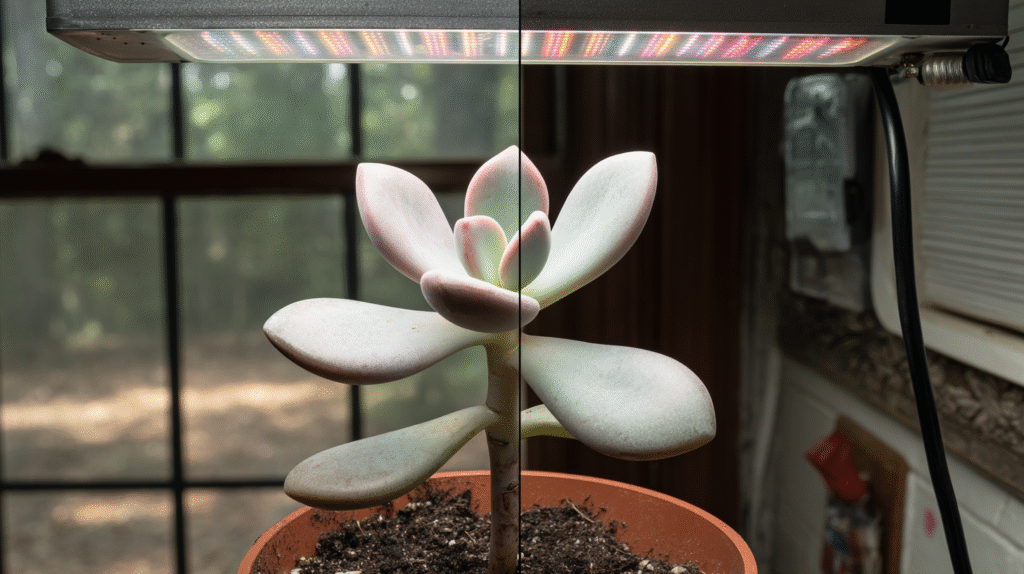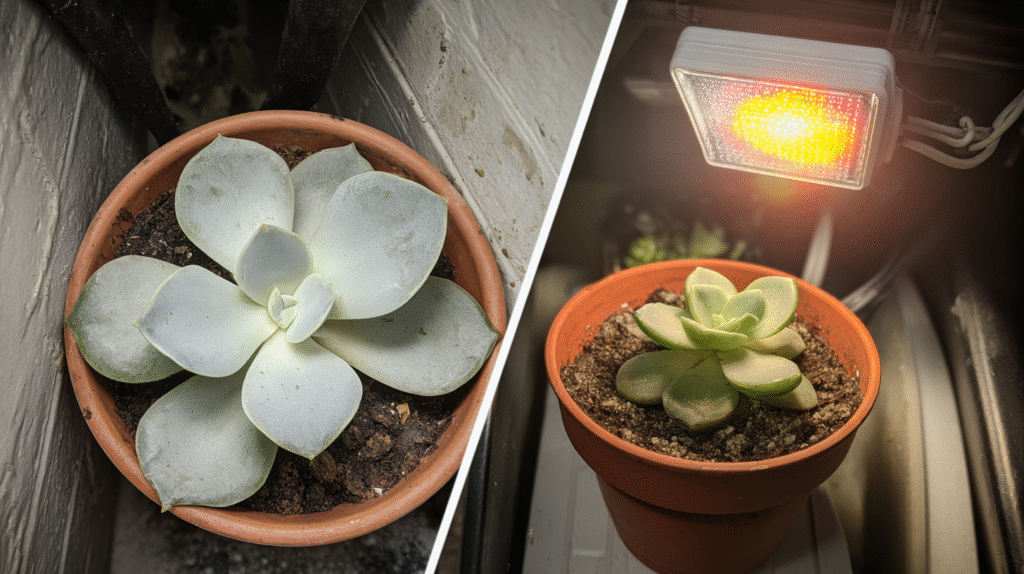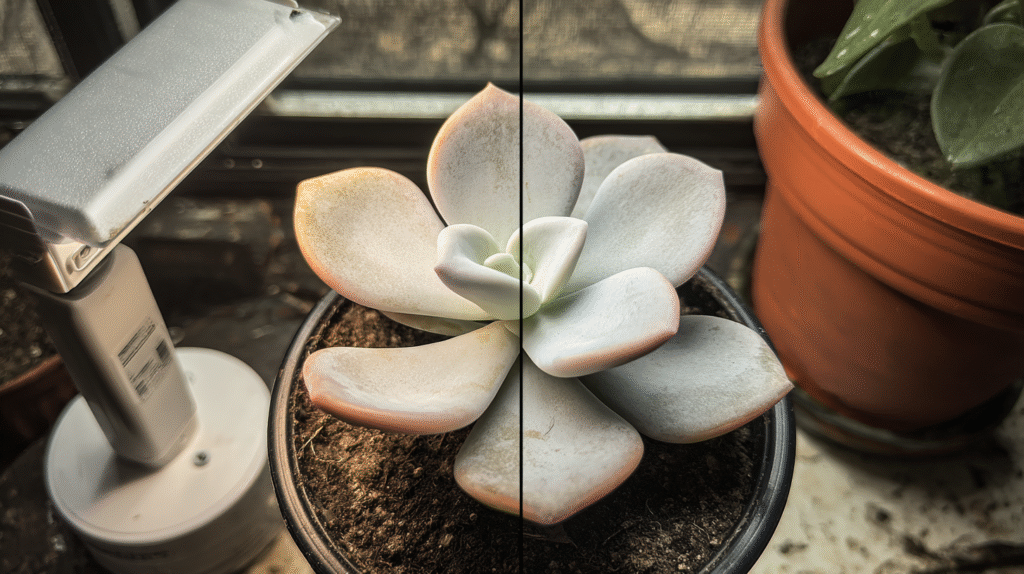My succulents were dying a slow, stretchy death. In my north-facing apartment, my once-compact echeverias looked like drunk giraffes, and my “sun-loving” sedums had turned into pale, leggy nightmares. I’d already killed $200 worth of plants trying to make them work with my crappy natural light.
Then I discovered grow lights. Not the fancy $500 setups you see on Instagram – just regular, affordable lights that transformed my sad succulent graveyard into something I’m actually proud to show people. After three years of testing everything from cheap Amazon bulbs to professional fixtures, here’s what actually works.
Why Your Succulents Actually Need Grow Lights
Let’s get real – unless you live in a glass house in Arizona, your succulents probably aren’t getting enough light. Here’s what convinced me to finally invest in grow lights:
The Stretch Test Look at your succulents. Are they:
- Leaning dramatically toward the window?
- Growing tall with spaces between leaves?
- Losing their compact rosette shape?
- Pale or losing their vibrant colors?
If yes, they’re literally reaching for more light. My “moonstone” echeveria had grown 6 inches tall trying to find the sun. That’s not growth – that’s desperation.
The Window Reality Check
Even my “bright” east window only got 3-4 hours of direct light. Succulents want 6-8 hours minimum. Do the math – it wasn’t adding up, and neither were my plants thriving.

Types of Grow Lights: What’s Worth Your Money
I’ve wasted money on terrible lights so you don’t have to. Here’s the breakdown:
LED Grow Lights (The Winners)
- Energy efficient – my electric bill barely changed
- Last for years (mine are going on year 3)
- Run cool – won’t cook your plants
- Full spectrum options available
- Price range: $20-200
Fluorescent Tubes (The Old Reliable)
- T5 and T8 tubes work well
- Cheaper upfront than LEDs
- Need to be replaced yearly
- Run slightly warm
- Good for shelf setups
Incandescent/Halogen (Don’t Bother)
- Too hot
- Energy hogs
- Wrong light spectrum
- Will literally cook your succulents
The Specs That Actually Matter
After drowning in technical jargon, here’s what you really need to know:
Lumens (Brightness)
- 2000-3000 lumens per square foot minimum
- More is generally better for succulents
- My 4000 lumen setup keeps everything compact
Kelvin (Color Temperature)
- 5000K-6500K is ideal (daylight spectrum)
- 3000K works but growth is slower
- Mix of both is perfect but not necessary
Wattage
- Actual watts vs. “equivalent” watts are different
- My 30-watt LED panel equals a 150-watt traditional bulb
- Focus on lumens, not watts
Coverage Area
- Manufacturers lie about this constantly
- A “4 square foot” light really covers about 2
- I use multiple smaller lights vs. one big one
My Current Setup (That Actually Works)
After killing plants with bad lighting and burning others with lights too close, here’s what I landed on:
For My Shelving Unit:
- Barrina T5 LED strips (linked two together)
- Mounted under each shelf
- 12 inches from plants
- On for 12-14 hours daily
- Cost: $30 per shelf
For Individual Plants:
- Sansi 36W full spectrum bulbs in desk lamps
- 8-10 inches from plants
- Adjustable necks for positioning
- $25 per bulb + cheap lamp
For My Propagation Station:
- Spider Farmer SF-300 LED panel
- Overkill? Maybe. But propagation success went from 50% to 95%
- 18 inches from props
- Worth the $70 investment

Distance and Duration: The Sweet Spot Formula
This took months of trial and error to figure out:
LED Lights:
- High-light succulents (Echeveria, Sedum): 6-12 inches
- Moderate-light (Haworthia, Gasteria): 12-18 inches
- Start farther away and move closer gradually
Duration:
- Start with 10 hours daily
- Increase to 12-14 hours for most succulents
- 16 hours for really light-hungry varieties
- Use a timer – consistency is everything
Signs You’re Too Close:
- Brown spots (sunburn)
- Crispy leaf edges
- Bleached colors
- Closed rosettes (trying to protect themselves)
Signs You’re Too Far:
- Still stretching
- Pale colors
- Slow/no growth
- Leaning toward light
Common Mistakes I Made (So You Don’t Have To)
The 24/7 Mistake
Thought more light = better growth. Left lights on constantly. Plants got stressed, stopped growing, some died. Succulents need darkness too – stick to 12-16 hours max.
The Cheap Light Trap
Bought those $15 “grow light” bulbs from Amazon. They’re usually just colored regular bulbs. Complete waste. Spend the extra $10 for actual grow lights.
The Distance Disaster
Put lights 2 inches from my echeverias because I wanted fast results. Burned half my collection. Now I always start far and move closer gradually.
Ignoring Heat
Even LEDs produce some heat. Learned this when I crammed lights too close under a shelf and created a succulent oven. Always check temperature at plant level.
Real Results: Before and After Grow Lights
My Echeveria Collection:
- Before: Stretched, pale, dying lower leaves
- After 3 months: Compact rosettes, vibrant colors, offsetting like crazy
Propagation Success:
- Before: 50% success rate, 3-4 weeks to root
- After: 95% success, roots in 10-14 days
Overall Collection:
- Before: Buying new plants to replace dead ones monthly
- After: Giving away pups because I have too many

Budget-Friendly Options That Don’t Suck
You don’t need to spend hundreds. Here’s what works on a budget:
Under $50 Setup:
- 2-3 regular lamp fixtures: $20
- Sansi or GE grow bulbs: $25-30
- Timer: $5
- Total: Under $50 for 4-6 plants
Under $100 Setup:
- LED strip lights for shelves: $60
- Timer: $5
- Covers a whole bookshelf
- My friend uses this exact setup successfully
Advanced Tips I Wish I’d Known Earlier
Rotate Your Plants
Even with grow lights, rotate weekly for even growth. I mark my pots with a Sharpie dot to track rotation.
Summer vs. Winter Lighting
I reduce to 10-12 hours in summer when they get some natural light. Winter gets the full 14-16 hours.
Combining Natural and Artificial
My plants near windows get both. The grow lights supplement, not replace. Best of both worlds.
Light Stress for Colors
Want those gorgeous stress colors? Increase light intensity or duration slightly. My “Perle von Nurnberg” never had purple edges until I added grow lights.
Troubleshooting Common Issues
“My plants still aren’t growing”
- Check if lights are actually grow lights (not just labeled as such)
- Might need more than just light (water, temperature, soil issues)
- Some succulents grow slowly regardless
“Leaves are burning”
- Move lights farther away
- Reduce hours of exposure
- Some plants are more sensitive – adjust accordingly
“Electric bill went up”
- Check actual wattage
- Use timer to control hours
- LEDs should barely impact bill – if it’s significant, something’s wrong
The Bottom Line on Succulent Grow Lights
Three years ago, I was ready to give up on succulents entirely. My apartment was too dark, and I was tired of watching plants die. Now? I’ve got 50+ thriving succulents, successful props everywhere, and friends asking for cuttings.
The secret wasn’t finding perfect natural light – it was accepting that grow lights are a game-changer. Not fancy, expensive setups. Just basic, functional lights that give succulents what they actually need.
Start simple. Get one good bulb, put it in a lamp you already have, and watch what happens. Once you see your stretched echeveria form a tight rosette or your pale sedum develop vibrant colors, you’ll be hooked.
My only regret? Not starting sooner. Every stretched, dead succulent from my pre-grow light days could’ve been saved with a $25 bulb. Don’t make my mistake. Your succulents are begging for more light – give it to them. 💡






